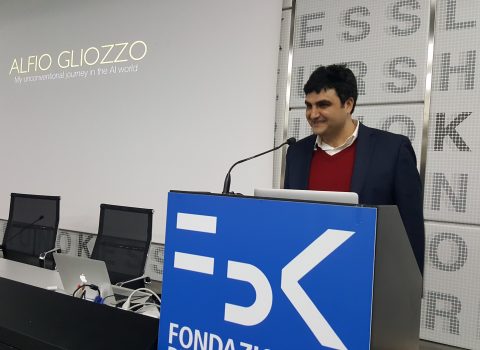MAIA: Artificial Intelligence is not only for robots
MAIA stands for Advanced Model of Artificial Intelligence and is the robot from which FBK initiated some of the main strands of its research in the field: speech recognition, digital visualization, natural language analysis and planning
It was 1988 when MAIA came to life. A real robot, with the ambition of being a concierge for the ITC-IRST guests. In its initial design, it vaguely reminds us of Star Wars’s R2-D2, only a bit more rough, as research prototypes typically are. It lacks those human or human-like features that lived in the imaginary of the robotics of the time, but it certainly had skills that were not quite common in those years.
All this happens in Trentino, which has always been renowned for its tourist attractions and much less famous for its research activities, albeit important.
The reason for this is explained by Paolo Traverso (director of FBK-ICT):
In the Sixties, in the Autonomous Province of Trento, there was the Trentino Institute of Culture (ITC) that included the University of Trento. When the latter passed under State administration in 1982, PAT, with Province President Bruno Kessler, decided to continue investing in research, with the idea of giving new opportunities to Trentino and avant-garde opportunities to its young people. And this is how in 1985 the ITC-IRST (Institute for Scientific and Technological Research) was entrusted to Luigi Stringa (formerly managing director of the Selenia – Elsag group).
More than thirty years have gone by, what kind of research was conducted at that time?
The institute devoted itself mainly to two areas: artificial intelligence and microsystems.
And MAIA was the result of the first one.
Yes, and it was mainly thanks to the vision of Director Stringa. Right from the start, the goal was to build an integrated system of artificial intelligence. This also included an implementation part and therefore an intelligent service robot. The idea was that this long term goal of deep integration would bring with it an integration made in the MAIA system, which would favor the growth of a number of parallel research areas. A role was also planned for the Microsystems Division to manufacture smart sensors to be integrated into MAIA’s robot.
So it is from this project that much of the research on artificial intelligence at FBK derived.
Thus frontier research groups in artificial vision, speech recognition, machine reasoning, natural language processing, knowledge based systems, human factors were set up. Each of these activities could count on a well-established researcher to coordinate each specific field. Many of the best young researchers from Italy and abroad were recruited, and in a short time the institute came to be ranked among the best research centers on the international scene. This allowed, among other things, to have a large number of projects accepted in the competition for European projects, and important industrial projects.
Among the protagonists of those years there is Oliviero Stock, one of the first researchers on artificial intelligence at ITC-IRST and in Italy.
But what was AI in those years?
Artificial intelligence (AI) was created with the aim of studying the theoretical foundations underlying human knowledge and reasoning, but at the same time also for the purposes of building computerized systems able to solve problems and perform reasoning operations typical of human beings. At the time of Stringa, there was a still strong debate between the vision of a “strong AI”, in which researchers tried to simulate the real processes of human reasoning – see for example deductive reasoning through tools like formal logic or those of learning through neural networks – and the opposite vision of a “weak AI”, according to which the important aspect was to build systems that could solve problems even with methods and techniques that did not simulate the reasoning of human beings. Weak or strong, at that time research in AI was organized in several quite sectorial and separate strands, such as the representation of knowledge and reasoning based on automatic deduction, automatic planning, cognitive models and natural language processing. artificial vision and speech recognition (only to mention some very relevant ones).
What were the results of that early research in AI?
Despite the initial encouraging results in these different sectors, in the nineties a series of high-impact expectations on the market and for the society were created and after not completely satisfied: it was the so-called “winter of the AI”, partly due to lack of recognition of the highly innovative results that AI was taking home (few know that current “window” systems on PCs are a result of AI) and partly due to the application of theories and techniques in a series of toy examples (not complex enough to then have an impact in practical applications). Famous is the case of the “block world” for automatic planning for robotics, an artificial world where the task was to move blocks on a table but with operations that could never fail.
What is the relationship between artificial intelligence and robotics?
Surely, in the relationship between the two we need to consider that the robots have great appeal and attraction for the general public, and that one of the questions that arises is whether we can really talk about intelligence without an “embodiment”, i.e. a body that relates to the environment and to human beings. But as far as the scientific aspects are concerned, it is only one of the available areas of research.
Now MAIA is a museum piece. Robotics and the integration of artificial intelligence into a single system are no longer a research goal at FBK. But since then, skills have been advanced and innovative research topics have been developed. We can say that MAIA has evolved and has taken new roads, bringing FBK up to its 3 current strategic objectives: Smart Factory, Samart Cities and Communities and Health and Healthcare. All in one direction: the good of people.



